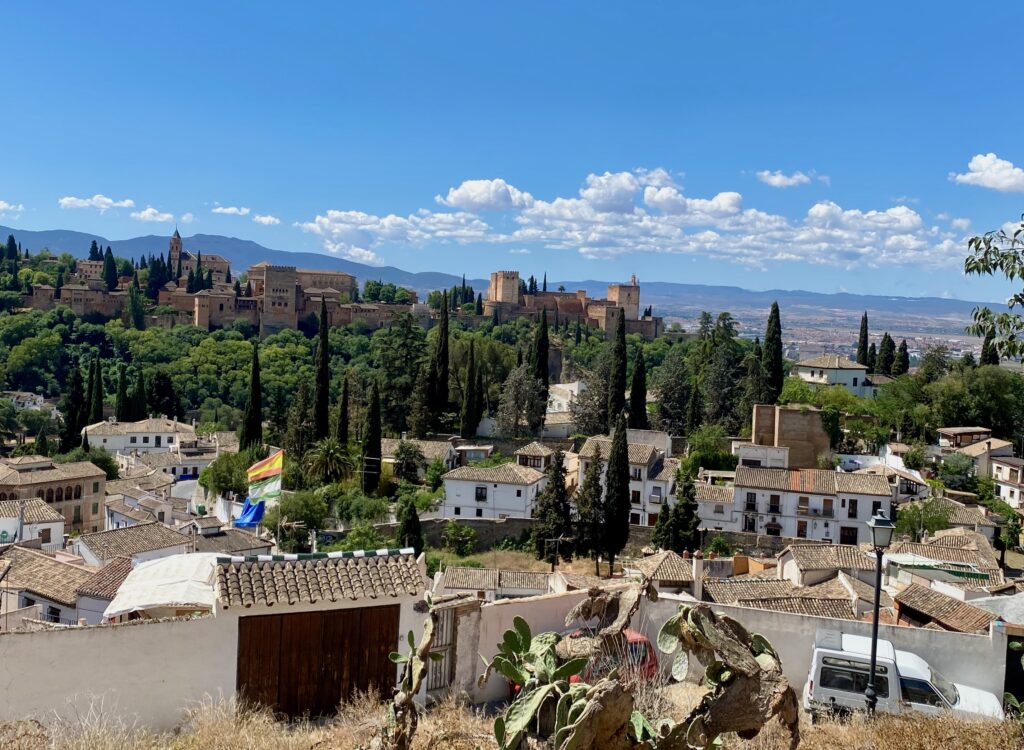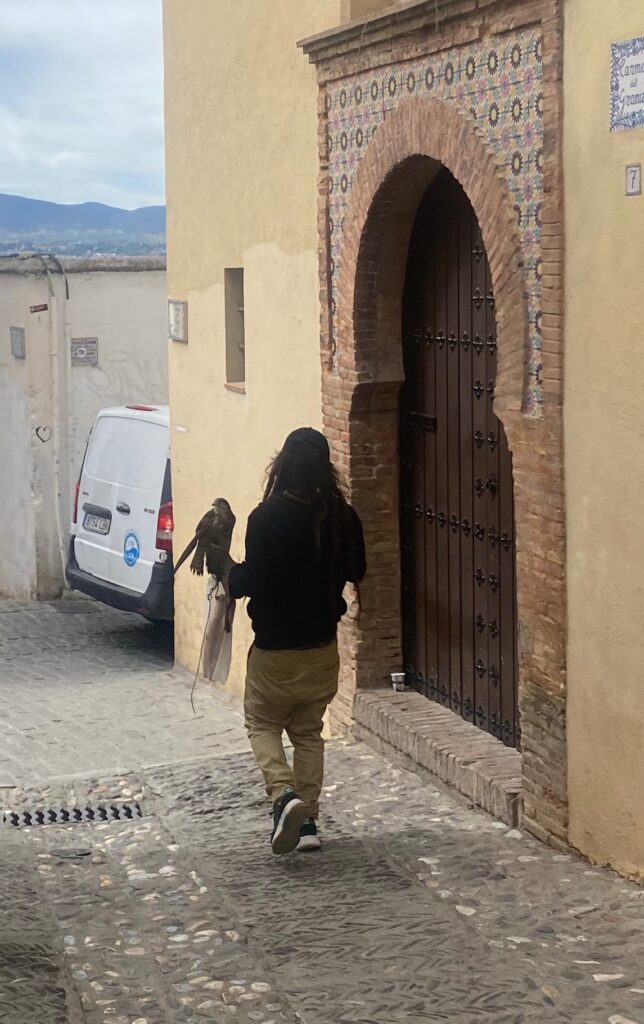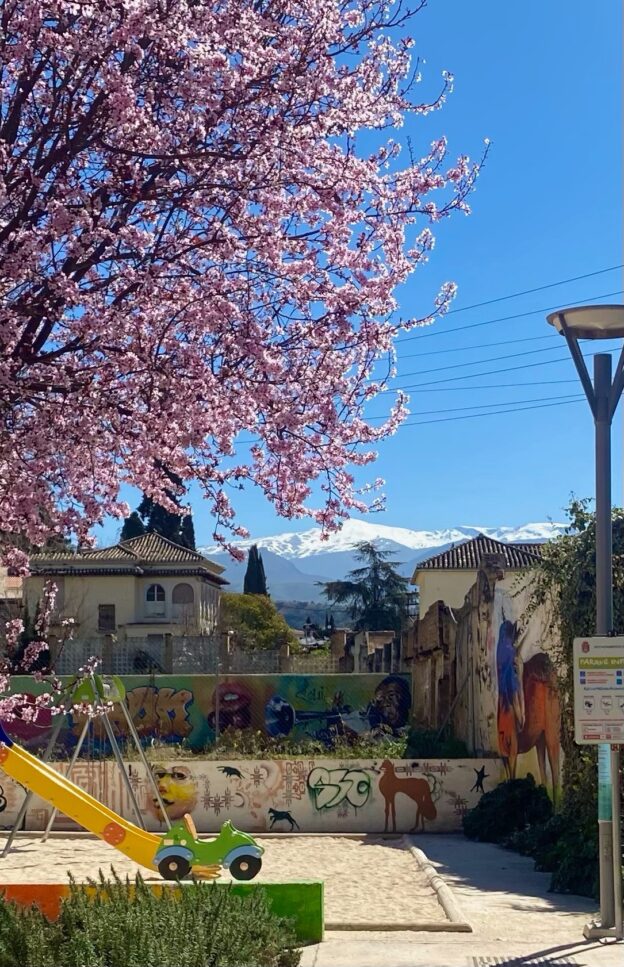- Facebook393
- Threads
- Bluesky
- Total 393
We’re leaving Granada tomorrow after living here for three months. My limited Spanish and a certain shyness have prevented me from learning a lot about contemporary life here. I feel better informed about the distant past than the present. Nevertheless, I’ll venture a few observations and hypotheses.
For those who have not seen it, the most salient feature of Granada is its beauty. The castle-palace of the Alhambra caps one hill, but around that romantic building are bigger summits, and the snow-capped Sierra Nevadas form the backdrop. Whitewashed houses with flowering gardens and little squares cascade down the hill of the Albaizin, where we lived. On the plain below are fine boulevards, marble-paved squares, and baroque domes.

Granada is not a big city. The population of the municipality is only 230,000. Although some legally protected green space has been lost, farmland and wooded hills remain in view. The university enrolls about 60,000 students, not concentrated on one campus but distributed through several neighborhoods. Numerous foreign students either visit the university or study Spanish in private schools. As a result, the population is quite youthful and informal. Hardly a business suit is seen.
Since three million people visit the Alhambra each year, the city is full of tourists. A substantial portion are Spanish, but Granada also draws people from the rest of the world, ranging from backpackers to bourgeois families to big tour groups. And there are many expats and some refugees. No particular foreign language dominates.
Andalusia is still fairly poor and dominated by agriculture. The region’s per capita GDP is $18,500, similar to Sicily’s and much lower than $42,000 for the EU as a whole. Many rural people moved to Granada in the postwar period and settled in neighborhoods like El Zaidin, where, apparently, conditions were at first pretty rough. I have walked through every part of the city proper and found all the streets pleasant: bustling, clean, safe, and well served by public transportation (including a brand-new subway line) and other facilities. Perhaps some of the apartments are small.
Rural life usually feels far away, but not always. We could regularly hear a burro bray from our house, and once we watched a man herd his goats up a nearby street.
Granada retains a small-town feel under the surface. On the bus that I often used to take home, the older clientele would frequently greet each other by name. People walk their dogs off-leash and leave them to wait outside of stores. Many enjoy a paseo in the late afternoon.
For me, a rough indicator of globalization is the variety of food. In Granada’s supermarkets, virtually all of the ingredients are meant for Andalusian dishes or Italian-style pizza and pasta. Except in the biggest “Ipermercado” and one little shop owned by a South Asian man, stores typically offer a single shelf with a few bottles of soy sauce and some “Old El Paso”-brand seasoning as their only foreign ingredients. Likewise, 98 percent of the city’s many restaurants offer Andalusian menus with very similar dishes. The situation is completely different in Madrid, where one can buy ingredients or cooked meals from anywhere in the world.
The previous paragraph is not a complaint. For one thing, Spanish food is good! Besides, we enjoyed being immersed in a place with a distinct culture. I do think Granada might be behind the curve (for better and worse) on globalization. That doesn’t mean it is unsophisticated, although some Castilians and Catalans may think so. For instance, the city boasts at least 14 independent bookstores, presumably serving the university community. It seems characteristic of Granada that these stores stock many new books for serious readers, yet almost every volume is in Spanish, and most are by Spanish authors. The same was true at the extensive annual book fair. One gets a sense of mild insularity–and pride.
There is a long and rich literary tradition of describing Granada as melancholy. As I wrote recently, Richard Wright observed Granada and all of Andalusia as fanatically Catholic, haunted by history, and static. I am reminded of how writers use the Turkish word hüzün (meaning something like “communal sadness”) to describe Istanbul. In both cases, outsiders are inspired by the tragic remains of past grandeur. In both cases, some local people adopt the visitors’ melancholy as their own. And both descriptions mislead.
In fact, Granada can give an impression of frivolity and subversiveness. Spanish people from other regions like to visit the city for pre-wedding parties. They dress in crazy matching costumes and tease the blindfolded fiancés. Although they are generally segregated into “hen” and “stag” groups, you see individuals expressing various gender identities. For every nun in a habit, there must be a hundred young people with tattoos and piercings. The graffiti art by El Niño de las Pinturas and others is well-known.

The first thing that Castilians say about Granada is that the Arab-Islamic heritage is strong there. They are not wrong. In our neighborhood, the layout, the surrounding walls, and the water system all date to the Emirate of Granada; and at the bottom of our hill, the Guadalquivir is simply the Wadi al-Kabir: the Big River.* More subtly, the streets are still repaved with black and white stones, a continuous practice since the Arab period; and even modern doors often have rows of iron studs that, in medieval times, would have been painted to indicate that the owner had accomplished the Hajj. Under our living room is a cistern, an aljibe, that is part of the irrigation system of Arab origin.
But I want to complicate this impression. First, the influence of Arab Islamic culture is far deeper in other places than many people realize. In English, there are about 900 words of Arabic origin, including “sugar” and “alcohol,” and there are about 4,000 in Spanish. Not only in Granada, but also in Chile and Texas, people use a lot of Arabic words. Americans eat meals in courses, wear lighter colors during the summer, and do many other things as a result of the customs of Arab al-Andalus.
Also, some of the explicitly Arabic influences in Andalusia are probably “invented traditions,” in Eric Hobsbawm’s phrase.
For instance, it’s worth experiencing an “Andalusian hammam” or Arab bath. That tradition dates all the way back to 1988. The Alcaicería is the city’s “bazaar” neighborhood, a warren of quaint shops. It burned to the ground in 1843, and the architecture you see there today is a Victorian fantasy of the Middle East. The Alhambra is one of the world’s greatest expressions of classical Arab culture, yet it probably consists of a selection of medieval buildings that had various owners and functions. Ferdinand and Isabella seized, heavily renovated and modified, and connected these buildings to form one renaissance-style palace, and then the rest of the neighborhood gradually vanished. The Alhambra has never stopped being transformed by ambitious architects who are responsible for things like the incongruous Victorian roofs and everything about its lovely gardens.
Arab and Romani/Gitano influences were as important for Granada’s modernists, Lorca and Manuel de Falla, as they have been for its folk arts, like flamenco. But this is not simply a case of the past influencing the present. For one thing, Arabs and Romani constitute living communities in Granada. In 2003, the Moroccan immigrant community of almost 5,000 people opened a beautiful new mosque across from the Alhambra, and Romani still dominate the Sacromonte district.
When audiences cry ¡Olé! to appreciate a flamenco dancer, they may be saying wa Ilâh (“by God”) in Arabic. Or that may be a false etymology that persisted as a myth because it sounded so romantic. In short, there is a long and complex history here of assimilation, appropriation, “othering,” ambivalence, celebration, nostalgia, and sheer invention. Andalusians have been hybrid and have been choosing to present themselves as hybrid ever since the Emirate.
Sad to leave Granada, I think of the last sultan, “Boabdil” (actually, Muhammad XII), and his famous “Moor’s Sigh” as he turned to face the Alhambra for the last time. Or of Carlos Cano’s lyrics:
| Deep in the cistern, what should appear But the sadness that killed Boabdil the emir. And I left it under the shadow of an almond tree On my way to the mountains of Guajar-Faragüit. To see whether, during the time of honey, There was a flowering of the light of thought, And whether the town will recover its color, That old-time Berber green-and-white. Oh, country children, Tender spikelets, Go and run to tell the earth That the poor wait for her at dawn. At dawn, old earth, at dawn… [my translation] | En el fondo de un aljibe me encontré la tristeza que matara al rey Boabdil. Y a la sombra de un almendro la dejé por los montes de Guajar-Faragüit. Por ver si cuando el tiempo de la miel la luz del pensamiento diera flor y el pueblo recobrara su color verdiblanco de origen bereber. Ay niños del campo, espiguitas tiernas, echad a correr. Decidle a la tierra que el pobre la espera al amanecer. Al amanecer la tierra, al amanecer… |
Then again, maybe nothing could be more typical of Granada than an American tourist (think: Washington Irving) recalling a mythologized medieval Andalusian Arab to taste some melancholic sublime on a cheerful day in a thriving city of tourists and students.
*Correction: the river at the bottom of our hill is the Darro, a tributary. See also: Richard Wright’s Pagan Spain; challenging the Reconquista; Lorca’s rivers; sabbatical update (from when we first arrived.)
